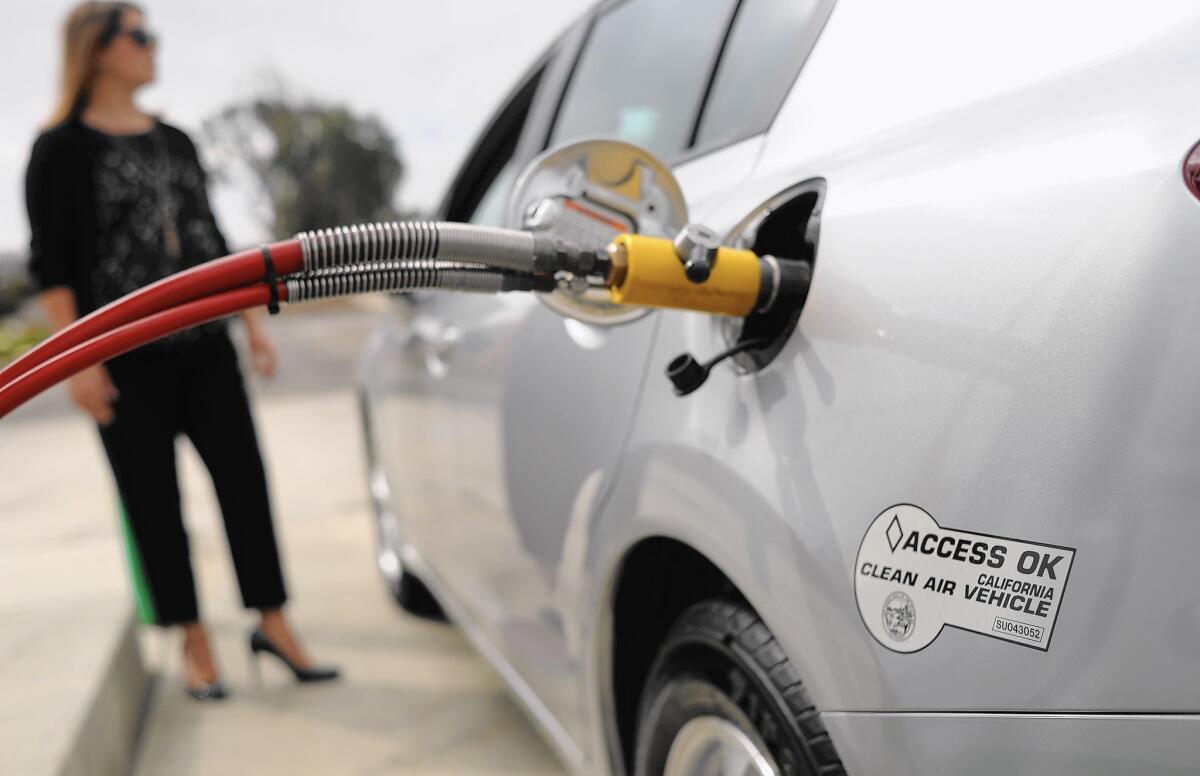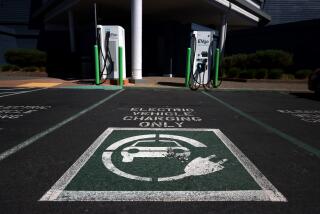What kind of car is the most green, fuel efficient and budget friendly?

Compressed natural gas tanks limit the size of the cabin and trunk, and driving range is limited.
- Share via
A decade ago, drivers who wanted to go green had little choice beyond Toyota’s Prius hybrid.
Today the selection of efficient, lower-pollution cars includes a bewildering array of technologies and models — hybrids, plug-in hybrids, battery electrics, diesels and hydrogen fuel cells. Conventional gasoline cars, meanwhile, have made great strides in going farther on less fuel.
But which technology is kindest to the planet? And which one fits your family’s budget and your commute?
With the help of the Union of Concerned Scientists, we examined seven powertrain options, analyzing their greenhouse gas emissions — including the power plant pollution required to produce electricity — along with their relative fuel efficiency and cost of operation.
The analysis looked at comparably-sized passenger cars and, where possible, different powertrains fitted into the same model. Costs were based on typical California fuel and electricity prices.
Battery electric cars — those that run solely on electricity — are the cleanest and least expensive to operate. But they typically get only about 80 miles of driving range on a full charge (Tesla’s Model S is the exception, traveling more than 250 miles on a charge, but it typically sells for about $100,000.)
Other drivetrains offer compelling combinations of efficiency and low emissions in a more practical, affordable package.
“Electric vehicles are the greenest choice for California drivers,” said Dave Reichmuth, senior engineer at the Union of Concerned Scientists. “But even switching to a more efficient gasoline vehicle can lead to significant emissions reductions and lower petroleum use.”
Here’s a breakdown of all the available drivetrain options.
Battery electric
For the true environmentalist, nothing beats an electric car charged by renewable energy sources. Homeowners with rooftop solar panels can literally drive on sunshine. Electric car buyers also get generous state and federal subsidies.
But even electric cars powered by the grid produce less carbon emissions than other vehicles. More surprising, the efficiency doesn’t necessarily exact a penalty in performance.
“A lot of people don’t realize that the electric motor has a lot more torque from a stop, which means the cars can be fun to drive,” Reichmuth said.
But there are drawbacks. All but the Tesla have ranges under 100 miles. They can take hours to charge. They are generally more expensive than a similar gasoline vehicle.
Hydrogen fuel cell
Hydrogen powered cars are finally entering the U.S. auto market after years of anticipation. Hyundai is leasing its Tucson fuel cell vehicle to consumers who live near the handful of hydrogen stations in California. Toyota plans to launch a fuel cell car called the Mirai this year, and Honda will offer its fuel cell car next year.
Like electric cars, fuel cells are expensive but come with generous government subsidies to buyers. The bigger obstacle for buyers will be fueling infrastructure — just 20 stations are expected to be in operation in California by the end of this year.
Because natural gas is used to make most hydrogen, fuel cell cars are also not as clean as battery electrics. On the plus side, they can be fueled up as quickly as gasoline vehicles and have a range of about 300 miles between refills.
“There is a path to zero emissions with fuel cell vehicles, but in reality they are about a decade behind plug-in vehicles in their development and deployment,” said Max Baumhefner, an attorney and automotive expert with the Natural Resources Defense Council.
Diesel
Although popular in Europe, diesel has never caught on in the U.S. You see it stateside in German passenger cars, domestic pickup trucks and in commercial trucking. But modern diesel engines are cleaner, less noisy and more efficient than they have ever been.
They also offer a great driving experience and ranges of more than 500 miles, making them ideal for those with long highway commutes. When it comes to carbon emissions “diesel pencils out about the same as an efficient gasoline car but not quite as efficient as the hybrids,” Reichmuth said.
Although only a handful of automakers sell diesel passenger cars in the U.S., the choices are good. Volkswagen, for example, offers a comfortable Jetta sedan and a utilitarian Golf station wagon. They get 36 and 35 mpg, respectively, in combined city and highway driving and easily reach 40 mpg-plus on open roads. BMW offers the sporty 320d sedan, which gets even better combined driving fuel economy, according to the federal Environmental Protection Agency.
Compressed natural gas
Once thought of as a promising transitional technology on the road to hydrogen and electric cars, compressed natural gas cars have driven into a dead end. Honda is discontinuing its natural gas Civic after the current model year, and no other automaker is stepping in with a passenger car that runs only on CNG.
Natural gas cars are only a little more polluting than a comparable hybrid, and they are less expensive to fuel. But the CNG tanks take up too much space, limiting the size of the cabin and trunk, and their driving range is limited. The CNG Civic travels less than half the distance on one fueling than the gasoline model and only a third of the hybrid.
“CNG is probably a dead technology for consumers, but still useful for fleet operations,” Baumhefner said.
Hybrid
With the exception of the Toyota Prius, hybrids have never achieved the popularity some environmental groups and auto industry analysts expected. A variety of factors hold back sales. For instance, to reduce weight and improve fuel efficiency, automakers have removed sound deadening materials, allowing road and wind noise into the cabin, especially at highway speeds.
Hybrids cost more than regular cars. With the average price of regular gasoline now well under $3 a gallon nationally, the payback period on gas savings can be long.
Still, hybrids are a great choice for those who drive many miles — especially in stop-and-go traffic, when the cars recapture energy during braking to power electric motors that help propel the car and save gas. . A compact hybrid generates about 240 grams of carbon dioxide per mile, or just 55% of the amount generated by a conventional gasoline car that gets 25 mpg.
Some are exceptionally well done. The Honda Accord hybrid is a full-size, family sedan that gets 47 mpg in combined driving and goes more than 550 miles between gas station stops.
Plug-in hybrid
Plug-in hybrids run on electricity until their batteries are drained and then switch to gasoline. They’re the Swiss Army knife of green cars.
“If you are a one-car family and you have a daily commute of under 40 miles then something like a Chevy Volt is perfect,” Baumhefner said. “You are driving on about $1 a gallon equivalent and displacing a lot of emissions. And you still have the extra range to go to grandma’s on the weekend.”
The Volt has an all-electric range of 38 miles. As a group, Volt owners drive about 60% of their miles on electricity alone. Many drive nearly exclusively on electricity, using the gas mode only for long-distance trips. That’s why Volt carbon emissions approach the levels of fuel cell vehicles and battery-only electric cars. It’s also one of the least expensive vehicles to operate. Just $6.83 in power and fuel will take you 100 miles. Those numbers are expected to improve for owners of the next generation Volt, which comes out this year with an all-electric range of 50 miles.
But not all plug-in hybrids are equal. The Prius plug-in has an all-electric range of just 11 miles, making it barely useful for running the children back and forth to school. The all-electric mode on the Accord plug-in is just 13 miles.
Gasoline
Don’t write off the internal combustion engine as an efficient option, especially until automakers can make alternative drivetrains less expensive and more practical. Automakers have greatly improved gas mileage in recent years and offer a wider range of economical gasoline models.
There are dozens of gasoline vehicles on the market that get 30 mpg or better in everyday driving. The Honda Civic, for example, achieves 33 miles per gallon in combined city and highway driving and reaches 39 mpg on open roads. It does this while producing only about 75% of the carbon dioxide of a gasoline car that averages 25 mpg. The sporty Mazda3 does even better. Both cars have long ranges — more than 400 miles between refills.
These vehicles also cost less to buy than those with alternative fuel powertrains, although they produce about a third more pollution per mile than a comparably sized hybrid.
Twitter: @latimesjerry







